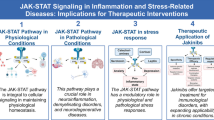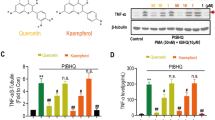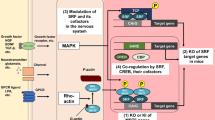Abstract
Endocannabinoids (eCBs) and glucocorticoids (GCs) are two distinct classes of signaling lipids that exert both neuroprotective and immunosuppressive effects; however, the possibility of an actual interaction of their receptors [i.e., type-2 cannabinoid (CB2) and glucocorticoid receptor α (GRα), respectively] remains unexplored. Here, we demonstrate that the concomitant activation of CB2 and GRα abolishes the neuroprotective effects induced by each receptor on central neurons and on glial cells in animal models of remote cell death. We also show that the ability of eCBs and GCs, used individually, to inhibit tumour necrosis factor-α (TNF-α) and interferon-γ (IFN-γ) production from activated human T lymphocytes is lost when CB2 and GRα are activated simultaneously. In addition, signal transduction pathways triggered by concomitant activation of both receptors led to increased levels of GRβ, heat-shock proteins-70 and -90, and p-JNK, as well as to reduced levels of p-STAT6. These effects were reversed only by selectively antagonizing CB2, but not GRα. Overall, our study demonstrates for the first time the existence of a CB2-driven negative cross-talk between eCB and GC signaling in both rats and humans, thus paving the way to the possible therapeutic exploitation of CB2 as a new target for chronic inflammatory and neurodegenerative diseases.






Similar content being viewed by others
References
Maccarrone M (2009) The endocannabinoid system and its manifold central actions. In: Tettamanti G, Goracci G (eds) Handbook of neurochemistry and molecular neurobiology—neural lipids. Springer, Germany, pp 385–405
Klein TW, Newton C, Larsen K, Lu L, Perkins I, Nong L, Friedman H (2003) The cannabinoid system and immune modulation. J Leukoc Biol 74(4):486–496
Howlett AC, Blume LC, Dalton GD (2010) CB(1) cannabinoid receptors and their associated proteins. Curr Med Chem 17(14):1382–1393
Graham ES, Angel CE, Schwarcz LE, Dunbar PR, Glass M (2010) Detailed characterisation of CB2 receptor protein expression in peripheral blood immune cells from healthy human volunteers using flow cytometry. Int J Immunopathol Pharmacol 23(1):25–34
Cencioni MT, Chiurchiù V, Catanzaro G, Borsellino G, Bernardi G, Battistini L, Maccarrone M (2010) Anandamide suppresses proliferation and cytokine release from primary human T-lymphocytes mainly via CB2 receptors. PLoS One 5(1):e8688
Basu S, Dittel BN (2011) Unraveling the complexities of cannabinoid receptor 2 (CB2) immune regulation in health and disease. Immunol Res 51(1):26–38
Cabral GA, Griffin-Thomas L (2009) Emerging role of the cannabinoid receptor CB2 in immune regulation: therapeutic prospects for neuroinflammation. Expert Rev Mol Med 11:e3
Centonze D, Battistini L, Maccarrone M (2008) The endocannabinoid system in peripheral lymphocytes as a mirror of neuroinflammatory diseases. Curr Pharm Des 14(23):2370–2372
Van Sickle MD, Duncan M, Kingsley PJ, Mouihate A, Urbani P, Mackie K, Stella N, Makriyannis A, Piomelli D, Davison JS, Marnett LJ, Di Marzo V, Pittman QJ, Patel KD, Sharkey KA (2005) Identification and functional characterization of brainstem cannabinoid CB2 receptors. Science 310(6746):329–332
Onaivi ES, Ishiguro H, Gong JP, Patel S, Perchuk A, Meozzi PA, Myers L, Mora Z, Tagliaferro P, Gardner E, Brusco A, Akinshola BE, Liu QR, Hope B, Iwasaki S, Arinami T, Teasenfitz L, Uhl GR (2006) Discovery of the presence and functional expression of cannabinoid CB2 receptors in brain. Ann N Y Acad Sci 1074:514–536
Viscomi MT, Oddi S, Latini L, Pasquariello N, Florenzano F, Bernardi G, Molinari M, Maccarrone M (2009) Selective CB2 receptor agonism protects central neurons from remote axotomy-induced apoptosis through the PI3 K/Akt pathway. J Neurosci 29(14):4564–4570
Chrousos GP (1995) The hypothalamic-pituitary-adrenal axis and immune-mediated inflammation. N Engl J Med 332(20):1351–1362
Rhen T, Cidlowski JA (2005) Anti-inflammatory action of glucocorticoids —new mechanisms for old drugs. N Engl J Med 353(16):1711–1723
Chrousos GP, Kino T (2005) Intracellular glucocorticoid signaling: a formerly simple system turns stochastic. Sci STKE 2005(304):pe48
Kino T, Chrousos GP (2004) Glucocorticoid and mineralocorticoid receptors and associated diseases. Essays Biochem 40:137–155
Kino T, Su YA, Chrousos GP (2009) Human glucocorticoid receptor isoform beta: recent understanding of its potential implications in physiology and pathophysiology. Cell Mol Life Sci 66(21):3435–3448
Barnes PJ (2011) Glucocorticosteroids: current and future directions. Br J Pharmacol 163(1):29–43
Chiurchiù V, Maccarrone M (2011) Chronic inflammatory disorders and their redox control: from molecular mechanisms to therapeutic opportunities. Antioxid Redox Signal 15(9):2605–2641
Schacke H, Docke WD, Asadullah K (2002) Mechanisms involved in the side effects of glucocorticoids. Pharmacol Ther 96(1):23–43
Barnes PJ (2010) Mechanisms and resistance in glucocorticoid control of inflammation. J Steroid Biochem Mol Biol 120(2–3):76–85
Hill MN, McLaughlin RJ, Bingham B, Shrestha L, Lee TT, Gray JM, Hillard CJ, Gorzalka BB, Viau V (2010) Endogenous cannabinoid signaling is essential for stress adaptation. Proc Natl Acad Sci USA 107(20):9406–9411
Crosby KM, Bains JS (2012) The intricate link between glucocorticoids and endocannabinoids at stress-relevant synapses in the hypothalamus. Neuroscience 204:31–37
Viscomi MT, Florenzano F, Latini L, Amantea D, Bernardi G, Molinari M (2008) Methylprednisolone treatment delays remote cell death after focal brain lesion. Neuroscience 154(4):1267–1282
Oddi S, Latini L, Viscomi MT, Bisicchia E, Molinari M, Maccarrone M (2012) Distinct regulation of nNOS and iNOS by CB2 receptor in remote delayed neurodegeneration. J Mol Med 90(4):371–387
Goleva E, Li LB, Eves PT, Strand MJ, Martin RJ, Leung DY (2006) Increased glucocorticoid receptor beta alters steroid response in glucocorticoid-insensitive asthma. Am J Respir Crit Care Med 173(6):607–616
Rossi S, Bernardi G, Centonze D (2010) The endocannabinoid system in the inflammatory and neurodegenerative processes of multiple sclerosis and of amyotrophic lateral sclerosis. Exp Neurol 224(1):92–102
Rog DJ (2010) Cannabis-based medicines in multiple sclerosis—a review of clinical studies. Immunobiology 215(8):658–672
Sandercock PA, Soane T (2011) Corticosteroids for acute ischaemic stroke. Cochrane Database Syst Rev 9:CD000064
Hillard CJ (2008) Role of cannabinoids and endocannabinoids in cerebral ischemia. Curr Pharm Des 14(23):2347–2361
Bracken MB (2012) Steroids for acute spinal cord injury. Cochrane Database Syst Rev 1:001046
Teasell RW, Mehta S, Aubut JA, Foulon B, Wolfe DL, Hsieh JT, Townson AF, Short C, Spinal Cord Injury Rehabilitation Evidence Research Team (2010) Spinal cord injury rehabilitation evidence research team. A systematic review of pharmacological treatments of pain after spinal cord injury. Arch Phys Med Rehabil 91(5):816–831
Baastrup C, Finnerup NB (2008) Pharmacological management of neuropathic pain following spinal cord injury. CNS Drugs 22(6):455–475
Dhawan N, Puangco J, Jandial R (2008) In search of a treatment for Alzheimer’s disease and potential immunosuppressive therapeutic interventions. Neurol Endocrinol Lett 29(4):410–420
Viscomi MT, Florenzano F, Latini L, Molinari M (2009) Remote cell death in the cerebellar system. Cerebellum 8(3):184–191
Viscomi MT, Florenzano F, Conversi D, Bernardi G, Molinari M (2004) Axotomy dependent purinergic and nitrergic co-expression. Neuroscience 123(2):393–404
Pacher P, Mackie K (2012) Interplay of cannabinoid 2 (CB2) receptors with nitric oxide synthases, oxidative and nitrative stress, and cell death during remote neurodegeneration. J Mol Med (Berl) 90(4):347–351
Viscomi MT, D’Amelio M, Cavallucci V, Latini L, Bisicchia E, Nazio F, Fanelli F, Maccarrone Moreno S, Cecconi F, Molinari M (2012) Stimulation of autophagy by rapamycin protects neurons from remote degeneration after acute focal brain damage. Autophagy 8(2):222–235
Viscomi MT, Oddi S, Latini L, Bisicchia E, Maccarrone M, Molinari M (2010) The endocannabinoid system: a new entry in remote cell death mechanisms. Exp Neurol 224(1):56–65
Rezai-Zadeh K, Gate D, Town T (2009) CNS infiltration of peripheral immune cells: D-day for neurodegenerative disease? J Neuroimmune Pharmacol 4(4):462–475
Ransohoff RM, Kivisakk P, Kidd G (2003) Three or more routes for leukocyte migration into the central nervous system. Nat Rev Immunol 3(7):569–581
Engelhardt B (2008) The blood-central nervous system barriers actively control immune cell entry into the central nervous system. Curr Pharm Des 14(16):1555–1565
Huang X, Reynolds AD, Mosley RL, Gendelman HE (2009) CD4+ T cells in the pathobiology of neurodegenerative disorders. J Neuroimmunol 211(1–2):3–15
Neumann H, Medana IM, Bauer J, Lassman H (2002) Cytotoxic T lymphocytes in autoimmune and degenerative CNS diseases. Trends Neurosci 25(6):313–319
Franchimont D, Galon J, Gadina M, Visconti R, Zhou Y, Aringer M, Frucht DM, Chrousos GP, O’Shea JJ (2000) Inhibition of Th1 immune response by glucocorticoids: dexamethasone selectively inhibits IL-12-induced Stat4 phosphorylation in T lymphocytes. J Immunol 164(4):1768–1774
Kunicka JE, Talle MA, Denhardt GH, Brown M, Prince LA, Goldstein G (1993) Immunosuppression by glucocorticoids: inhibition of production of multiple lymphokines by in vivo administration of dexamethasone. Cell Immunol 149(1):39–49
Monick MM, Aksamit TR, Geist LJ, Hunninghake GW (1994) Dexamethasone inhibits IL-1 and TNF activity in human lung fibroblasts without affecting IL-1 or TNF receptors. Am J Physiol 267(1 Pt 1):L33–L38
Murataeva N, Mackie K, Straiker A (2012) The CB2-preferring agonist JWH015 also potently and efficaciously activates CB1 in autaptic hippocampal neurons. Pharmacol Res 66(5):437–442
Matysiak M, Makosa B, Walczak A, Selmaj K (2008) Patients with multiple sclerosis resisted to glucocorticoid therapy: abnormal expression of heat-shock protein 90 in glucocorticoid receptor complex. Mult Scler 14(7):919–926
Meijer OC, Karssen AM, De Kloet ER (2003) Cell- and tissue-specific effects of corticosteroids in relation to glucocorticoid resistance: example from the brain. J Endocrinol 178(1):13–18
Dai J, Buijs R, Swaab D (2004) Glucocorticoid hormone (cortisol) affects axonal transport in human cortex neurons but shows resistance in Alzheimer’s disease. Br J Pharm 143(5):606–610
Tissing WJE, Meijerink JPP, den Boer ML, Pieters R (2003) Molecular determinants of glucocorticoid sensitivity and resistance in acute lymphoblastic leukemia. Leukemia 17(1):17–25
Gross KL, Lu NZ, Cidlowski JA (2009) Molecular mechanisms regulating glucocorticoid sensitivity and resistance. Mol Cell Endocrinol 300(1–2):7–16
Lewis-Tuffin LJ, Cidlowski JA (2006) The physiology of human glucocorticoid receptor beta (hGRbeta) and glucocorticoid resistance. Ann N Y Acad Sci 1069:1–9
Christodoulopoulos P, Leung DY, Elliott MW, Hogg JC, Muro S, Toda M, Laberge S, Hamid QA (2000) Increased number of glucocorticoid receptor-β-expressing cells in the airways in fatal asthma. J Allergy Clin Immunol 106(3):479–484
Hamid QA, Wenzel SE, Hauk PJ, Tsicopoulos A, Wallaert B, Lafitte JJ, Chrousos GP, Szefler SJ, Leung DYM (1999) Increased glucocorticoid receptor β in airway cells of glucocorticoid-insensitive asthma. Am J Respir Crit Care Med 159(5 Pt 1):1600–1604
Honda M, Orii F, Ayabe T, Imai S, Ashida T, Obara T, Kohgo Y (2000) Expression of glucocorticoid receptor β in lymphocytes of patients with glucocorticoid-resistant ulcerative colitis. J Gastroenterol 118(5):859–866
Sousa AR, Lane SJ, Cidlowski JA, Staynov DZ, Lee TH (2000) Glucocorticoid resistance in asthma is associated with elevated in vivo expression of the glucocorticoid receptor β-isoform. J Allergy Clin Immunol 105(5):943–950
Kojika S, Sugita K, Inukai T, Saito M, Iijima K, Tezuka T, Goi K, Shiraishi K, Mori T, Ozaraki T, Kagami K, Ohyama K, Nakazawa S (1996) Mechanisms of glucocorticoid resistance in human leukemic cells: implication of abnormal 90 and 70 kDa heat shock proteins. Leukemia 10(6):994–999
Qian X, Zhu Y, Xu W, Lin Y (2001) Glucocorticoid receptor and heat shock protein 90 in peripheral blood mononuclear cells from asthmatics. Chin Med J (England) 114(10):1051–1054
Gorzalka BB, Dang SS (2012) Endocannabinoids and gonadal hormones: bidirectional interactions in physiology and behavior. Endocrinology 153(3):1016–1024
Hill MN, Tasker JG (2012) Endocannabinoid signaling, glucocorticoid-mediated negative feedback, and regulation of the hypothalamic-pituitary-adrenal axis. Neuroscience 204:5–16
Lopez HH (2010) Cannabinoid-hormone interactions in the regulation of motivational processes. Horm Behav 58(1):100–110
Parolaro D, Rubino T, Viganò D, Massi P, Guidali C, Realini N (2010) Cellular mechanisms underlying the interaction between cannabinoid and opioid system. Curr Drug Targ 11(4):393–405
Ferré S, Lluis C, Justinova Z, Quiroz C, Orru M, Navarro G, Canela EL, Franco R, Goldeberg SR (2010) Adenosine-cannabinoid receptor interactions. Implications for striatal function. Br J Pharm 160(3):443–453
Acknowledgments
This study was supported by Wings for Life Spinal Cord Research Foundation to M.T. Viscomi, by the Ministero della Salute to M. Molinari, and partly by Fondazione TERCAS (grant 2009–2012) to M. Maccarrone.
Conflict of interest
The authors declare that they have no conflict of interest.
Author information
Authors and Affiliations
Corresponding author
Additional information
E. Bisicchia and V. Chiurchiù contributed equally to the work.
M. Maccarrone and M. Molinari were equally senior authors.
Electronic supplementary material
Below is the link to the electronic supplementary material.
18_2012_1253_MOESM1_ESM.tif
Supplementary Fig. 1 Single or combined pharmacological activation of GRα and CB2 does not affect cytokine production from resting peripheral lymphocytes. Flow cytometric progressive gating and representative dot plots showing TNF-α and IFN-γ production from unstimulated CD4+ and CD8+ T lymphocytes treated or not with methylprednisolone (MPSS), JWH-015 or a combination of them (TIFF 28561 kb)
18_2012_1253_MOESM2_ESM.tif
Supplementary Fig. 2 Combined pharmacological activation of GRα and CB2 impairs cytokine production from peripheral lymphocytes. Histograms of TNF-α and IFN-γ production from unstimulated (CTRL) or PMA/Iono-activated CD4+ and CD8+ T lymphocytes treated or not with methylprednisolone (MPSS), GP 1A or a combination of them. One-way ANOVA (F = 10.06; p < 0.0001) followed by Bonferroni multiple comparison test was performed. Data are reported as mean ± SD (n=3). *p<0.01 versus PMA/Iono; # p<0.01 versus PMA/Iono-MPSS+GP 1A (TIFF 26571 kb)
Rights and permissions
About this article
Cite this article
Bisicchia, E., Chiurchiù, V., Viscomi, M.T. et al. Activation of type-2 cannabinoid receptor inhibits neuroprotective and antiinflammatory actions of glucocorticoid receptor α: when one is better than two. Cell. Mol. Life Sci. 70, 2191–2204 (2013). https://doi.org/10.1007/s00018-012-1253-5
Received:
Revised:
Accepted:
Published:
Issue Date:
DOI: https://doi.org/10.1007/s00018-012-1253-5




